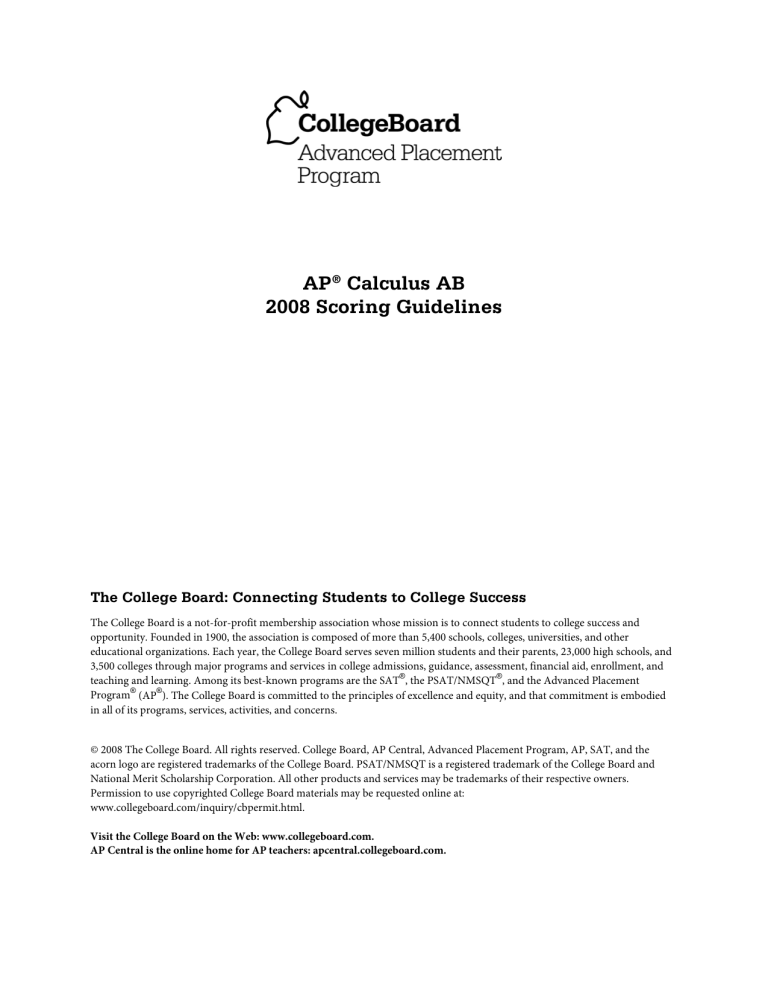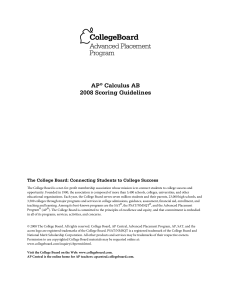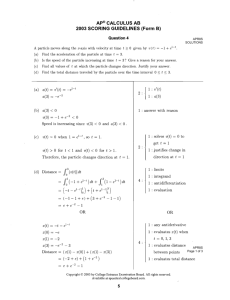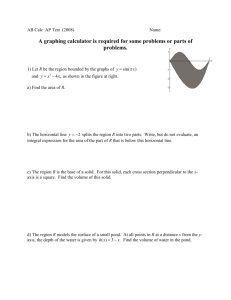
AP® Calculus AB
2008 Scoring Guidelines
The College Board: Connecting Students to College Success
The College Board is a not-for-profit membership association whose mission is to connect students to college success and
opportunity. Founded in 1900, the association is composed of more than 5,400 schools, colleges, universities, and other
educational organizations. Each year, the College Board serves seven million students and their parents, 23,000 high schools, and
3,500 colleges through major programs and services in college admissions, guidance, assessment, financial aid, enrollment, and
teaching and learning. Among its best-known programs are the SAT®, the PSAT/NMSQT®, and the Advanced Placement
Program® (AP®). The College Board is committed to the principles of excellence and equity, and that commitment is embodied
in all of its programs, services, activities, and concerns.
© 2008 The College Board. All rights reserved. College Board, AP Central, Advanced Placement Program, AP, SAT, and the
acorn logo are registered trademarks of the College Board. PSAT/NMSQT is a registered trademark of the College Board and
National Merit Scholarship Corporation. All other products and services may be trademarks of their respective owners.
Permission to use copyrighted College Board materials may be requested online at:
www.collegeboard.com/inquiry/cbpermit.html.
Visit the College Board on the Web: www.collegeboard.com.
AP Central is the online home for AP teachers: apcentral.collegeboard.com.
AP® CALCULUS AB
2008 SCORING GUIDELINES
Question 1
Let R be the region bounded by the graphs of y = sin (π x ) and y = x3 − 4 x, as shown in the figure
above.
(a) Find the area of R.
(b) The horizontal line y = −2 splits the region R into two parts. Write, but do not evaluate, an integral
expression for the area of the part of R that is below this horizontal line.
(c) The region R is the base of a solid. For this solid, each cross section perpendicular to the x-axis is a
square. Find the volume of this solid.
(d) The region R models the surface of a small pond. At all points in R at a distance x from the y-axis,
the depth of the water is given by h( x ) = 3 − x. Find the volume of water in the pond.
(a) sin (π x ) = x3 − 4 x at x = 0 and x = 2
Area =
∫ 0 ( sin (π x ) − ( x
2
3
− 4x
⎧ 1 : limits
⎪
3 : ⎨ 1 : integrand
⎪⎩ 1 : answer
) ) dx = 4
(b) x3 − 4 x = −2 at r = 0.5391889 and s = 1.6751309
The area of the stated region is
∫ r ( −2 − ( x
s
(c) Volume =
∫ 0 ( sin (π x ) − ( x
(d) Volume =
∫ 0 ( 3 − x ) ( sin (π x ) − ( x
2
2
3
− 4x
))
3
2
3
− 4x
)) dx
dx = 9.978
− 4x
) ) dx = 8.369 or 8.370
2:
{
1 : limits
1 : integrand
2:
{
1 : integrand
1 : answer
2:
{
1 : integrand
1 : answer
© 2008 The College Board. All rights reserved.
Visit the College Board on the Web: www.collegeboard.com.
AP® CALCULUS AB
2008 SCORING GUIDELINES
Question 2
t (hours)
0
1
3
4
7
8
9
L( t ) (people)
120
156
176
126
150
80
0
Concert tickets went on sale at noon ( t = 0 ) and were sold out within 9 hours. The number of people waiting in
line to purchase tickets at time t is modeled by a twice-differentiable function L for 0 ≤ t ≤ 9. Values of L( t ) at
various times t are shown in the table above.
(a) Use the data in the table to estimate the rate at which the number of people waiting in line was changing at
5:30 P.M. ( t = 5.5 ) . Show the computations that lead to your answer. Indicate units of measure.
(b) Use a trapezoidal sum with three subintervals to estimate the average number of people waiting in line during
the first 4 hours that tickets were on sale.
(c) For 0 ≤ t ≤ 9, what is the fewest number of times at which L′( t ) must equal 0 ? Give a reason for your answer.
(d) The rate at which tickets were sold for 0 ≤ t ≤ 9 is modeled by r ( t ) = 550te−t 2 tickets per hour. Based on the
model, how many tickets were sold by 3 P.M. ( t = 3) , to the nearest whole number?
(a) L′( 5.5 ) ≈
L( 7 ) − L( 4 ) 150 − 126
=
= 8 people per hour
7−4
3
(b) The average number of people waiting in line during the first 4 hours is
approximately
L(1) + L( 3)
L( 3) + L( 4 )
1 ⎛ L( 0 ) + L(1)
(3 − 1) +
(1 − 0 ) +
( 4 − 3) ⎞⎟
⎜
4⎝
2
2
2
⎠
= 155.25 people
(c) L is differentiable on [ 0, 9] so the Mean Value Theorem implies
L′( t ) > 0 for some t in (1, 3) and some t in ( 4, 7 ) . Similarly,
L′( t ) < 0 for some t in ( 3, 4 ) and some t in ( 7, 8 ) . Then, since L′ is
continuous on [ 0, 9] , the Intermediate Value Theorem implies that
L′( t ) = 0 for at least three values of t in [ 0, 9].
2:
2:
{
{
1 : estimate
1 : units
1 : trapezoidal sum
1 : answer
⎧ 1 : considers change in
⎪⎪
sign of L′
3: ⎨
⎪ 1 : analysis
⎩⎪ 1 : conclusion
OR
OR
The continuity of L on [1, 4] implies that L attains a maximum value
there. Since L( 3) > L(1) and L( 3) > L( 4 ) , this maximum occurs on
(1, 4 ) . Similarly, L attains a minimum on ( 3, 7 ) and a maximum on
( 4, 8 ) . L is differentiable, so L′( t ) = 0 at each relative extreme point
on ( 0, 9 ) . Therefore L′( t ) = 0 for at least three values of t in [ 0, 9].
⎧ 1 : considers relative extrema
⎪⎪
of L on ( 0, 9 )
3: ⎨
1
:
analysis
⎪
⎪⎩ 1 : conclusion
[Note: There is a function L that satisfies the given conditions with
L′( t ) = 0 for exactly three values of t.]
(d)
3
∫ 0 r ( t ) dt = 972.784
2:
There were approximately 973 tickets sold by 3 P.M.
{
1 : integrand
1 : limits and answer
© 2008 The College Board. All rights reserved.
Visit the College Board on the Web: www.collegeboard.com.
AP® CALCULUS AB
2008 SCORING GUIDELINES
Question 3
Oil is leaking from a pipeline on the surface of a lake and forms an oil slick whose volume increases at a
constant rate of 2000 cubic centimeters per minute. The oil slick takes the form of a right circular cylinder
with both its radius and height changing with time. (Note: The volume V of a right circular cylinder with
radius r and height h is given by V = π r 2 h. )
(a) At the instant when the radius of the oil slick is 100 centimeters and the height is 0.5 centimeter, the
radius is increasing at the rate of 2.5 centimeters per minute. At this instant, what is the rate of change
of the height of the oil slick with respect to time, in centimeters per minute?
(b) A recovery device arrives on the scene and begins removing oil. The rate at which oil is removed is
R( t ) = 400 t cubic centimeters per minute, where t is the time in minutes since the device began
working. Oil continues to leak at the rate of 2000 cubic centimeters per minute. Find the time t when
the oil slick reaches its maximum volume. Justify your answer.
(c) By the time the recovery device began removing oil, 60,000 cubic centimeters of oil had already
leaked. Write, but do not evaluate, an expression involving an integral that gives the volume of oil at
the time found in part (b).
(a) When r = 100 cm and h = 0.5 cm,
and
dV
= 2000 cm3 min
dt
dr
= 2.5 cm min.
dt
⎧ 1 : dV = 2000 and dr = 2.5
⎪
dt
dt
⎪
4: ⎨
dV
2 : expression for
⎪
dt
⎪⎩ 1 : answer
dV
dr
dh
= 2π r h + π r 2
dt
dt
dt
2000 = 2π (100 )( 2.5 )( 0.5 ) + π (100 )2
dh
dt
dh
= 0.038 or 0.039 cm min
dt
(b)
dV
dV
= 2000 − R( t ) , so
= 0 when R( t ) = 2000.
dt
dt
This occurs when t = 25 minutes.
dV
dV
Since
> 0 for 0 < t < 25 and
< 0 for t > 25,
dt
dt
the oil slick reaches its maximum volume 25 minutes after the
device begins working.
(c) The volume of oil, in cm3 , in the slick at time t = 25 minutes
is given by 60,000 +
25
∫0
( 2000 − R( t ) ) dt.
⎧ 1 : R( t ) = 2000
⎪
3 : ⎨ 1 : answer
⎪⎩ 1 : justification
2:
{
1 : limits and initial condition
1 : integrand
© 2008 The College Board. All rights reserved.
Visit the College Board on the Web: www.collegeboard.com.
AP® CALCULUS AB
2008 SCORING GUIDELINES
Question 4
A particle moves along the x-axis so that its velocity at time t, for 0 ≤ t ≤ 6, is given by a differentiable
function v whose graph is shown above. The velocity is 0 at t = 0, t = 3, and t = 5, and the graph has
horizontal tangents at t = 1 and t = 4. The areas of the regions bounded by the t-axis and the graph of v on
the intervals [ 0, 3] , [3, 5] , and [5, 6] are 8, 3, and 2, respectively. At time t = 0, the particle is at x = −2.
(a) For 0 ≤ t ≤ 6, find both the time and the position of the particle when the particle is farthest to the left.
Justify your answer.
(b) For how many values of t, where 0 ≤ t ≤ 6, is the particle at x = −8 ? Explain your reasoning.
(c) On the interval 2 < t < 3, is the speed of the particle increasing or decreasing? Give a reason for your
answer.
(d) During what time intervals, if any, is the acceleration of the particle negative? Justify your answer.
(a) Since v( t ) < 0 for 0 < t < 3 and 5 < t < 6, and v( t ) > 0
for 3 < t < 5, we consider t = 3 and t = 6.
3
x( 3) = −2 +
∫ 0 v( t ) dt = −2 − 8 = −10
x( 6 ) = −2 +
∫ 0 v( t ) dt = −2 − 8 + 3 − 2 = −9
⎧ 1 : identifies t = 3 as a candidate
⎪⎪
6
3 : ⎨ 1 : considers ∫ v( t ) dt
0
⎪
⎪⎩ 1 : conclusion
6
Therefore, the particle is farthest left at time t = 3 when
its position is x( 3) = −10.
(b) The particle moves continuously and monotonically from
x( 0 ) = −2 to x( 3) = −10. Similarly, the particle moves
continuously and monotonically from x( 3) = −10 to
x( 5 ) = −7 and also from x( 5 ) = −7 to x( 6 ) = −9.
⎧ 1 : positions at t = 3, t = 5,
⎪⎪
and t = 6
3: ⎨
⎪ 1 : description of motion
⎪⎩ 1 : conclusion
By the Intermediate Value Theorem, there are three values
of t for which the particle is at x( t ) = −8.
(c) The speed is decreasing on the interval 2 < t < 3 since on
this interval v < 0 and v is increasing.
(d) The acceleration is negative on the intervals 0 < t < 1 and
4 < t < 6 since velocity is decreasing on these intervals.
1 : answer with reason
2:
{
1 : answer
1 : justification
© 2008 The College Board. All rights reserved.
Visit the College Board on the Web: www.collegeboard.com.
AP® CALCULUS AB
2008 SCORING GUIDELINES
Question 5
Consider the differential equation
dy
y −1
= 2 , where x ≠ 0.
dx
x
(a) On the axes provided, sketch a slope field for the given differential
equation at the nine points indicated.
(Note: Use the axes provided in the exam booklet.)
(b) Find the particular solution y = f ( x ) to the differential equation with
the initial condition f ( 2 ) = 0.
(c) For the particular solution y = f ( x ) described in part (b), find
lim f ( x ) .
x →∞
(a)
(b)
2:
1
1
dy = 2 dx
y −1
x
1
ln y − 1 = − + C
x
y −1 = e
y − 1 = ke
−1 = ke
−
−
−
1
x,
1 : zero slopes
1 : all other slopes
⎧ 1 : separates variables
⎪ 2 : antidifferentiates
⎪
6 : ⎨ 1 : includes constant of integration
⎪ 1 : uses initial condition
⎪
⎩ 1 : solves for y
1
− +C
x
y − 1 = eC e
{
1
x
where k = ±eC
1
2
Note: max 3 6 [1-2-0-0-0] if no constant
of integration
Note: 0 6 if no separation of variables
1
k = −e 2
1 1
− )
(
f ( x) = 1 − e 2 x , x > 0
(c) lim 1 − e
x →∞
( 12 − 1x ) = 1 −
e
1 : limit
© 2008 The College Board. All rights reserved.
Visit the College Board on the Web: www.collegeboard.com.
AP® CALCULUS AB
2008 SCORING GUIDELINES
Question 6
Let f be the function given by f ( x ) =
f ′( x ) =
ln x
for all x > 0. The derivative of f is given by
x
1 − ln x
.
x2
(a) Write an equation for the line tangent to the graph of f at x = e 2 .
(b) Find the x-coordinate of the critical point of f. Determine whether this point is a relative minimum, a
relative maximum, or neither for the function f. Justify your answer.
(c) The graph of the function f has exactly one point of inflection. Find the x-coordinate of this point.
(d) Find lim f ( x ) .
x → 0+
( )
(a) f e 2 =
ln e 2
1 − ln e 2
1
2
2
′
=
=− 4
f
e
=
,
2
2
2
e
e
e
e2
( )
( )
( )
An equation for the tangent line is y =
(
)
2
1
− 4 x − e2 .
2
e
e
(b) f ′( x ) = 0 when x = e. The function f has a relative maximum
at x = e because f ′( x ) changes from positive to negative at
x = e.
1
− x 2 − (1 − ln x ) 2 x −3 + 2ln x
for all x > 0
=
(c) f ′′( x ) = x
x4
x3
⎧1: x = e
⎪
3 : ⎨ 1 : relative maximum
⎪⎩ 1 : justification
⎧ 2 : f ′′( x )
3: ⎨
⎩ 1 : answer
f ′′( x ) = 0 when −3 + 2ln x = 0
x = e3
2
The graph of f has a point of inflection at x = e3
f ′′( x ) changes sign at x = e3 2 .
(d) lim
x →0
+
ln x
= −∞ or Does Not Exist
x
( )
2
2
⎪⎧ 1 : f e and f ′ e
2: ⎨
⎪⎩ 1 : answer
2
because
1 : answer
© 2008 The College Board. All rights reserved.
Visit the College Board on the Web: www.collegeboard.com.





